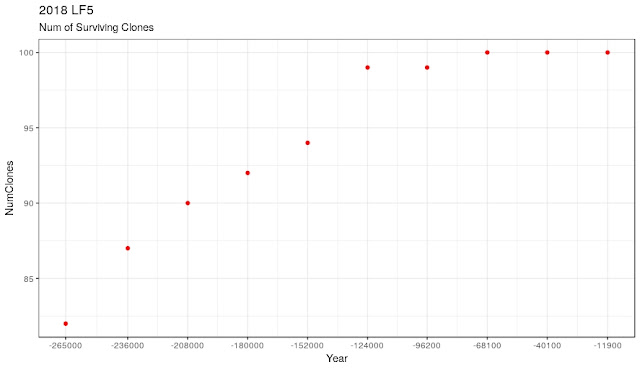Its orbit is still uncertain (condition code 6).
At the time of writing, it seems that this Amor has some potential to have a cometary origin. More details below.
Clones Generation
I generated 100 clones trying to achieve an orbital parameter distribution (mean and 1-sigma) that matches as far as possible the target nominal data read from Horizons Web a few hours ago on July 6th.
This is a comparison table that shows the clones distribution versus the target one:
This is a comparison table that shows the clones distribution versus the target one:
| clones_mean | clones_sd | target_mean | target_sd | |
| q | 1.06373506 | 3.2E-06 | 1.06373514 | 3.21E-06 |
| e | 0.61855794 | 7.847E-05 | 0.61856034 | 7.85E-05 |
| i | 41.04180418 | 0.001757 | 41.04185685 | 0.0017567 |
| peri | 181.03405996 | 0.00019308 | 181.03405317 | 0.00019281 |
| node | 100.75809149 | 0.00030458 | 100.75808179 | 0.00030512 |
| tp | 2458309.05107042 | 0.00017576 | 2458309.05106226 | 0.0001761 |
Backward simulation
I used the Mercury Integrator by John E. Chambers (with some subroutines supplied by Hal Levison and Martin Duncan).
Integration parameters
----------------------
Algorithm: Bulirsch-Stoer (general)
Integration start epoch: 2458200.5000000 days
Integration stop epoch: -100000000.0000000
Output interval: 100.000
Output precision: medium
Initial timestep: .050 days
Accuracy parameter: 1.0000E-12
Central mass: 1.0000E+00 solar masses
J_2: 0.0000E+00
J_4: 0.0000E+00
J_6: 0.0000E+00
Ejection distance: 1.0000E+02 AU
Radius of central body: 5.0000E-03 AU
Simulation results
LF_91 ejected at -60075 9 16.03454
sun was hit by LF_54 at -112260 1 30.7
sun was hit by LF_38 at -115727 5 28.2
sun was hit by LF_72 at -117581 3 8.3
sun was hit by LF_17 at -133748 2 27.5
sun was hit by LF_46 at -136245 9 8.1
LF_63 ejected at -144164 7 8.61087
sun was hit by LF_61 at -149555 10 11.3
sun was hit by LF_69 at -174783 1 21.9
LF_48 ejected at -193993 10 9.15850
sun was hit by LF_71 at -194558 6 14.5
LF_84 ejected at -218748 7 12.96343
sun was hit by LF_81 at -222146 6 1.6
sun was hit by LF_43 at -225535 3 27.2
LF_39 ejected at -235862 11 1.20080
sun was hit by LF_28 at -240288 5 16.1
LF_20 ejected at -244214 1 9.02367
LF_95 ejected at -245994 9 18.71844
LF_100 ejected at -262161 2 11.44480
sun was hit by LF_65 at -265855 6 9.3
LF_77 ejected at -269187 3 12.79012
LF_11 ejected at -277829 10 18.10824
The same information can be displayed in a graphical form, where we can see that the number of clones (initial number 100) is decreasing as you go in the past:
Simulation Graphs
In the following graphs, the simulation period was divided into 10 intervals.
In every interval, the maximum value of the relevant orbital parameter was found for every clone and all clones values are finally displayed in a boxplot.
Orbit Specific energy
In the picture below:
energy = 0 parabolic orbit
energy > 0 hyperbolic orbit
energy <0 elliptical orbit
Just for curiosity, the distribution of V-infinity for the 7 hyperbolic clones is as follows:
Inclination
Eccentricity
Kind Regards,
Alessandro Odasso





No comments:
Post a Comment
Note: Only a member of this blog may post a comment.